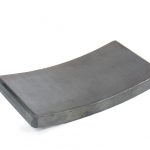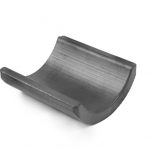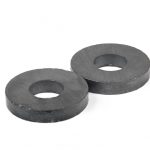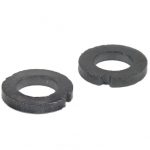Ferrite Magnets
- General information
- Learn More
- Property Table
- Photo Gallery
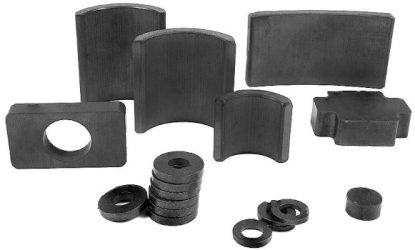
- Hard Ferrite: Y20-Y40
- higher coercivity and remanence after magnetization than soft Ferrite.
We are able to custom the shape and coating for your specific requirements.
General Introduction
Ferrites are usually non-conductive ferromagnetic ceramic compounds derived from iron oxides such as hematite (Fe2O3) or magnetite (Fe3O4) as well as oxides of other metals. In terms of the magnetic properties, the different ferrites are often classified as “soft” or “hard”, which refers to their low or high magnetic coercivity.
Features
Soft Ferrite has low coercivity, which means the material’s magnetization can easily reverse direction without dissipating much energy (hysteresis losses), while the material’s high resistivity prevents eddy currents in the core, another source of energy loss. Permanent ferrite magnets are made of Hard Ferrites, which have a higher coercivity and remanence after magnetization than soft Ferrite.
Ferrites are, like most other ceramics, hard and brittle.
Typical Grades
Hard Ferrite: Y20-Y40
Property
- Remanence (Br), measure the strength of the magnetic field;
- Coercivity (Hcb / Hcj), the material’s resistance to becoming demagnetized;
- Energy product (BHmax), the density of magnetic energy, which relates to the magnetic flux output per unit volume. Higher values indicate stronger magnets;
Shape
- Disk/Cylinder, Bar/Block, Ring, Arc, etc.
Application
- Electronic Inductors
- RF Transformers
- Microphones
- Loudspeakers
- Electro-acoustic Instrument Pickups
- Magnetic Separator
Production
Ferrite:
Raw Materials → Pre-Sintering → Milling → Granulation → Dry/Wet Press in Magnetic Field → Sintering → Machining → Magnetization → General Inspecting → Packing & Delivery
General Introduction
Ferrites are usually non-conductive ferromagnetic ceramic compounds derived from iron oxides such as hematite (Fe2O3) or magnetite (Fe3O4) as well as oxides of other metals. In terms of the magnetic properties, the different ferrites are often classified as “soft” or “hard”, which refers to their low or high magnetic coercivity.
Features
Soft Ferrite has low coercivity, which means the material’s magnetization can easily reverse direction without dissipating much energy (hysteresis losses), while the material’s high resistivity prevents eddy currents in the core, another source of energy loss. Permanent ferrite magnets are made of Hard Ferrites, which have a higher coercivity and remanence after magnetization than soft Ferrite.
Ferrites are, like most other ceramics, hard and brittle.
Typical Grades
Hard Ferrite: Y20-Y40
Property
- Remanence (Br), measure the strength of the magnetic field;
- Coercivity (Hcb / Hcj), the material’s resistance to becoming demagnetized;
- Energy product (BHmax), the density of magnetic energy, which relates to the magnetic flux output per unit volume. Higher values indicate stronger magnets;
Shape
Ferrite magnets could be made into various shapes:
- Disk/Cylinder, Bar/Block, Ring, Arc, etc.
Custom design is available to us for client`s specific needs.
Application
Some examples of Soft Ferrite applications:
- Electronic Inductors
- RF Transformers
Some examples of Hard Ferrite applications:
- Microphones
- Loudspeakers
- Electro-acoustic Instrument Pickups
- Magnetic Separator
Production
Ferrite:
Raw Materials → Pre-Sintering → Milling → Granulation → Dry/Wet Press in Magnetic Field → Sintering → Machining → Magnetization → General Inspecting → Packing & Delivery
